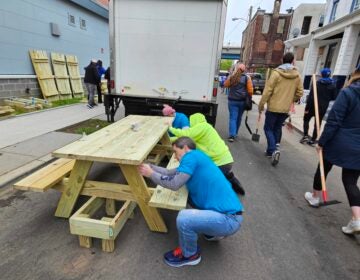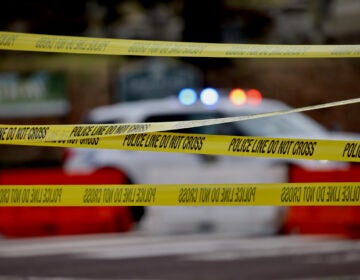NW Philly’s Ivy Ridge Trail planners shoot for 2015 opening
It’s one small step for the Manayunk Bridge project and a giant leap for trail users.
On Monday night, project leaders and residents of both city and suburbs gathered in Manayunk for the first of three public meetings regarding the Ivy Ridge Trail. The proposed six-tenths of a mile trail, which will begin at the terminus of the Manayunk Bridge at Dupont and High Streets and continue to the Ivy Ridge regional rail station, will serve as an important connection for walkers and bike riders looking to link up with the section of the Schuylkill River Trail that ultimately leads to Conshohocken and beyond.
Project leaders described the Ivy Ridge Trail as being the second phase of planned or envisioned work along the Schuylkill River, the first being the Manayunk Bridge project.
Jeff Riegner, vice-president of Whitman, Requardt, and Associates, the Wilmington-based firm that was awarded the bridge contract in 2011, said that most of the funding is in place for the Manayunk Bridge and that construction plans are nearly complete. Construction could begin as soon as the summer of 2013 and would take approximately 8 to 12 months.
“It’s pretty close to becoming reality,” Riegner said in reference to the bridge.
Seeking community input
For the Ivy Ridge Trail to be realized, project leaders are seeking public input and collaboration in a series of workshops that will aid in developing the second phase of the project.
Describing the project, Riegner identified four sections of the trail, each with very different characteristics.
Exiting the Manayunk Bridge, the Leverington Avenue portion is elevated and features both a viaduct and a retaining wall. Riegner said that the bridge is sound, but could use some “cosmetic help,” and suggested that railings and fencing would be installed.
Approaching the cobblestone Canton Street area, the former SEPTA right-of-way widens, suggesting to Riegner “lots of trail opportunities,” despite its current use as an ad-hoc parking area.
At the Fountain Street section, Riegner noted the predominant feature is a set of steps that allow pedestrians to access the towpath from Umbria Street.
Reaching the Ivy Ridge train station, connections exist to bike lanes on Umbria Street and to transit. However, crossing the heavily-used train station parking lot poses a challenge to project leaders.
Riegner said that unlike the existing towpath, “our goal is for Ivy Ridge Trail to be a place in itself but to also serve that transportation function.”
Within this conceptual framework, he said there are four conditions that must be met: A connection to existing bike lanes on Umbria Street to ensure the transportation aspect of the design, safety and security for trail users, a plan that works within SEPTA’s right-of-way, and a final design that is suitable to the current financial climate.
Addressing the need for a multi-use trail
Following Riegner’s presentation, local residents pored over four aerial photographs detailing segments of the Ivy Ridge Trail, offering comments and making suggestions with markers and Post-It notes.
John Kase, a River Road resident who, prior to his retirement, commuted along the trail for 30 years spoke up at the workshop. He praised the proposal, and said afterward that his contribution was to make designers aware of problems “they already knew about,” emphasizing the “conflict” between riders and pedestrians along Umbria Street.
It was a theme echoed by Marlene Schleifer, vice-president of the Ridge Park Civic Association and a 22-year resident of the neighborhood. She said that getting bicyclists off of Umbria Street would improve both bicycle safety as well as those of pedestrians.
“I go to the Ivy Ridge train station every day,” she said, “and I’m just as likely to be hit by a bicycle as someone in a car.”
In response, Riegner emphasized that the trail would be a multi-use trail.
East Falls resident Shawn Megill Legendre said he was excited to see what designers will do with the information gathered. Noting the many potential users of the trail – be they drivers, bikers, or pedestrians – Legendre said balancing their collective interests was an important aspect of the project.
“It’s going to be key with this trail,” he observed.
What’s next?
While workshop organizers lamented that more residents destined to be impacted by the project weren’t present – prior to the meeting, they leafleted the area – two neighborhood residents, a young couple, had their sole fear allayed: Dogs will be allowed on the trail.
Beyond local response, Riegner said there has been a “groundswell of support for trail projects all throughout the Delaware Valley.”
With the first public component complete, designers will now incorporate the suggestions and have a second meeting.
Prior to the adoption of the plan, a third public meeting will be held to explain aspects of the feasibility study, which will include design, costs, and ways to build momentum similar to that associated with the Manayunk Bridge.
The third phase, final design, will occur when funding is identified. While Riegner noted that no money is in place presently, having a completed project “takes you to the front of the list” for grants.
Riegner said the “optimistic” date for the trail’s completion in 2015, and at some later date, the Ivy Ridge Trail will extend to Shawmont to connect directly with the Schuylkill River Trail.
“Hopefully,” said Riegner in droll fashion, “within the lifespan of some of the people in this room.”
WHYY is your source for fact-based, in-depth journalism and information. As a nonprofit organization, we rely on financial support from readers like you. Please give today.




